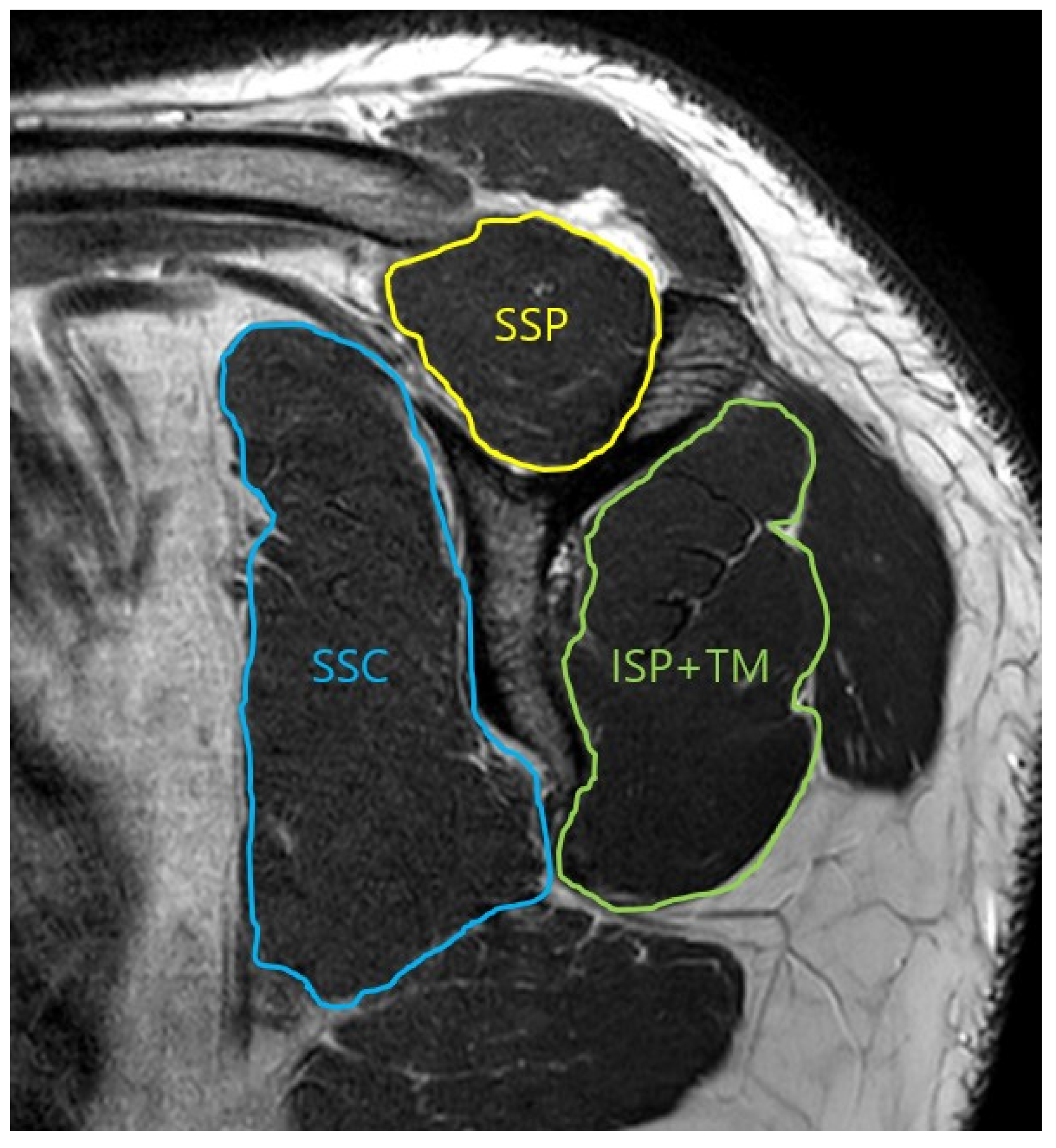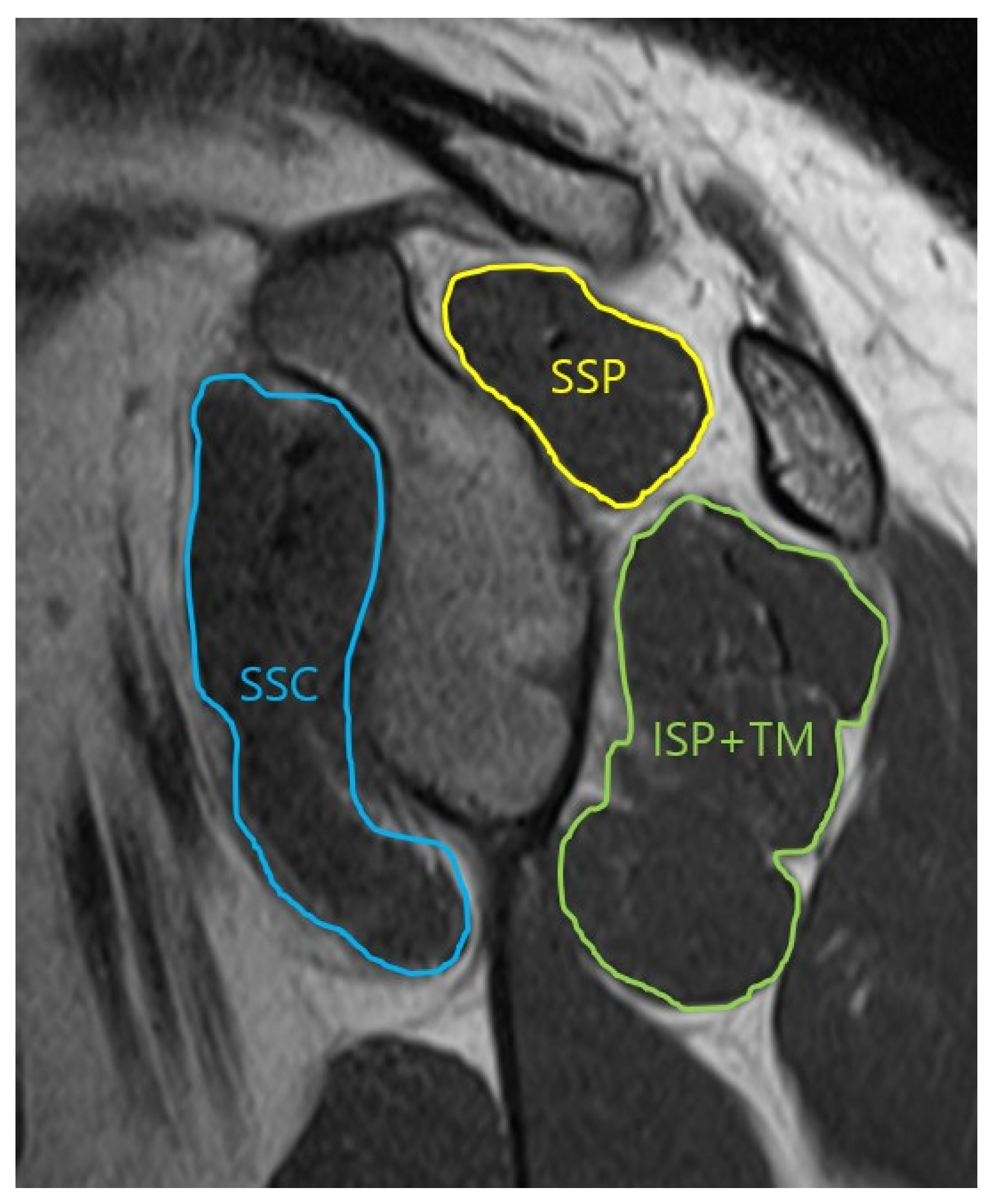Rotator Cuff Muscle Imbalance in Patients with Chronic Anterior Shoulder Instability
Abstract
1. Introduction
2. Materials and Methods
2.1. Patient Selection
2.2. Muscle Area Measurement
2.3. Statistical Analysis
3. Results
3.1. Inter-Observer and Intra-Observer Reliability
3.2. Y View Analysis
3.3. Glenoid Face View Analysis
4. Discussion
5. Conclusions
Author Contributions
Funding
Institutional Review Board Statement
Informed Consent Statement
Data Availability Statement
Acknowledgments
Conflicts of Interest
References
- Kim, S.C.; Yoo, J.C.; Park, J.H.; Bukhary, H.; Choi, Y.S.; Kang, K.T.; Kim, C.H. Changes in Shoulder Trauma during the COVID-19 Pandemic: A South Korean Survey. Clin. Orthop. Surg. 2023, 15, 300–307. [Google Scholar] [CrossRef]
- Weber, A.E.; Bolia, I.K.; Horn, A.; Villacis, D.; Omid, R.; Tibone, J.E.; White, E.; Hatch, G.F. Glenoid Bone Loss in Shoulder Instability: Superiority of Three-Dimensional Computed Tomography over Two-Dimensional Magnetic Resonance Imaging Using Established Methodology. Clin. Orthop. Surg. 2021, 13, 223–228. [Google Scholar] [CrossRef] [PubMed]
- Yiannakopoulos, C.K.; Mataragas, E.; Antonogiannakis, E. A comparison of the spectrum of intra-articular lesions in acute and chronic anterior shoulder instability. Arthroscopy 2007, 23, 985–990. [Google Scholar] [CrossRef] [PubMed]
- Fares, M.Y.; Boufadel, P.; Daher, M.; Koa, J.; Khanna, A.; Abboud, J.A. Anterior Shoulder Instability and Open Procedures: History, Indications, and Clinical Outcomes. Clin. Orthop. Surg. 2023, 15, 521–533. [Google Scholar] [CrossRef]
- Lander, R.D.; O’Donnell, M.J. Chronic locked anterior shoulder dislocation with impaction of the humeral head onto the coracoid: A case report. Clin. Shoulder Elb. 2023, 26, 212–216. [Google Scholar] [CrossRef]
- Shin, S.J.; Kim, J.H.; Ahn, J. Arthroscopic Latarjet procedure: Current concepts and surgical techniques. Clin. Shoulder Elb. 2023, 26, 445–454. [Google Scholar] [CrossRef] [PubMed]
- Dodson, C.C.; Cordasco, F.A. Anterior glenohumeral joint dislocations. Orthop. Clin. N. Am. 2008, 39, 507–518, vii. [Google Scholar] [CrossRef] [PubMed]
- Sonnery-Cottet, B.; Saithna, A.; Quelard, B.; Daggett, M.; Borade, A.; Ouanezar, H.; Thaunat, M.; Blakeney, W.G. Arthrogenic muscle inhibition after ACL reconstruction: A scoping review of the efficacy of interventions. Br. J. Sports Med. 2019, 53, 289–298. [Google Scholar] [CrossRef]
- Baumeister, J.; Reinecke, K.; Schubert, M.; Weiss, M. Altered electrocortical brain activity after ACL reconstruction during force control. J. Orthop. Res. 2011, 29, 1383–1389. [Google Scholar] [CrossRef]
- Baumeister, J.; Reinecke, K.; Weiss, M. Changed cortical activity after anterior cruciate ligament reconstruction in a joint position paradigm: An EEG study. Scand. J. Med. Sci. Sports 2008, 18, 473–484. [Google Scholar] [CrossRef]
- Rice, D.A.; McNair, P.J. Quadriceps arthrogenic muscle inhibition: Neural mechanisms and treatment perspectives. Semin. Arthritis Rheum. 2010, 40, 250–266. [Google Scholar] [CrossRef]
- Kellis, E.; Mademli, L.; Patikas, D.; Kofotolis, N. Neuromuscular interactions around the knee in children, adults and elderly. World J. Orthop. 2014, 5, 469–485. [Google Scholar] [CrossRef]
- Perraton, L.; Clark, R.; Crossley, K.; Pua, Y.H.; Whitehead, T.; Morris, H.; Telianidis, S.; Bryant, A. Impaired voluntary quadriceps force control following anterior cruciate ligament reconstruction: Relationship with knee function. Knee Surg. Sports Traumatol. Arthrosc. 2017, 25, 1424–1431. [Google Scholar] [CrossRef]
- Lowe, T.; Dong, X.N. The Use of Hamstring Fatigue to Reduce Quadriceps Inhibition after Anterior Cruciate Ligament Reconstruction. Percept. Mot. Skills 2018, 125, 81–92. [Google Scholar] [CrossRef]
- Apreleva, M.; Parsons, I.M.t.; Warner, J.J.; Fu, F.H.; Woo, S.L. Experimental investigation of reaction forces at the glenohumeral joint during active abduction. J. Shoulder Elb. Surg. 2000, 9, 409–417. [Google Scholar] [CrossRef]
- Espinosa-Uribe, A.G.; Negreros-Osuna, A.A.; Gutierréz-de la, O.J.; Vílchez-Cavazos, F.; Pinales-Razo, R.; Quiroga-Garza, A.; Elizondo-Riojas, G.; Elizondo-Omaña, R.E.; Guzmán-López, S. An age- and gender-related three-dimensional analysis of rotator cuff transverse force couple volume ratio in 304 shoulders. Surg. Radiol. Anat. 2017, 39, 127–134. [Google Scholar] [CrossRef]
- Hsu, J.E.; Reuther, K.E.; Sarver, J.J.; Lee, C.S.; Thomas, S.J.; Glaser, D.L.; Soslowsky, L.J. Restoration of anterior-posterior rotator cuff force balance improves shoulder function in a rat model of chronic massive tears. J. Orthop. Res. 2011, 29, 1028–1033. [Google Scholar] [CrossRef] [PubMed]
- Lee, J.H.; Park, J.S.; Hwang, H.J.; Jeong, W.K. Time to peak torque and acceleration time are altered in male patients following traumatic shoulder instability. J. Shoulder Elb. Surg. 2018, 27, 1505–1511. [Google Scholar] [CrossRef] [PubMed]
- Lee, J.H.; Park, J.S.; Jeong, W.K. Which muscle performance can be improved after arthroscopic Bankart repair? J. Shoulder Elb. Surg. 2020, 29, 1681–1688. [Google Scholar] [CrossRef]
- Rhee, S.M.; Nashikkar, P.S.; Park, J.H.; Jeon, Y.D.; Oh, J.H. Changes in Shoulder Rotator Strength After Arthroscopic Capsulolabral Reconstruction in Patients with Anterior Shoulder Instability. Orthop. J. Sports Med. 2021, 9, 2325967120972052. [Google Scholar] [CrossRef] [PubMed]
- Saccol, M.F.; Zanca, G.G.; Ejnisman, B.; de Mello, M.T.; Mattiello, S.M. Shoulder rotator strength and torque steadiness in athletes with anterior shoulder instability or SLAP lesion. J. Sci. Med. Sport. 2014, 17, 463–468. [Google Scholar] [CrossRef]
- Ishikawa, H.; Smith, K.M.; Wheelwright, J.C.; Christensen, G.V.; Henninger, H.B.; Tashjian, R.Z.; Chalmers, P.N. Rotator cuff muscle imbalance associates with shoulder instability direction. J. Shoulder Elb. Surg. 2023, 32, 33–40. [Google Scholar] [CrossRef]
- Fuchs, B.; Weishaupt, D.; Zanetti, M.; Hodler, J.; Gerber, C. Fatty degeneration of the muscles of the rotator cuff: Assessment by computed tomography versus magnetic resonance imaging. J. Shoulder Elb. Surg. 1999, 8, 599–605. [Google Scholar] [CrossRef]
- Henninger, H.B.; Christensen, G.V.; Taylor, C.E.; Kawakami, J.; Hillyard, B.S.; Tashjian, R.Z.; Chalmers, P.N. The Muscle Cross-sectional Area on MRI of the Shoulder Can Predict Muscle Volume: An MRI Study in Cadavers. Clin. Orthop. Relat. Res. 2020, 478, 871–883. [Google Scholar] [CrossRef] [PubMed]
- Strandberg, S.; Wretling, M.L.; Wredmark, T.; Shalabi, A. Reliability of computed tomography measurements in assessment of thigh muscle cross-sectional area and attenuation. BMC Med. Imaging 2010, 10, 18. [Google Scholar] [CrossRef] [PubMed]
- Myers, J.B.; Lephart, S.M. Sensorimotor deficits contributing to glenohumeral instability. Clin. Orthop. Relat. Res. 2002, 400, 98–104. [Google Scholar] [CrossRef] [PubMed]
- Amako, M.; Arino, H.; Tsuda, Y.; Tsuchihara, T.; Nemoto, K. Recovery of Shoulder Rotational Muscle Strength After Arthroscopic Bankart Repair. Orthop. J. Sports Med. 2017, 5, 2325967117728684. [Google Scholar] [CrossRef] [PubMed]
- Tahta, M.; Akmese, R.; Ozberk, Z.N.; Coskun, O.O.; Isik, C.; Korkusuz, F.; Bozkurt, M. Muscle strength and function of shoulders with Bankart lesion after successful arthroscopic treatment: Interlimb comparison 24 months after surgery. Arch. Orthop. Trauma. Surg. 2013, 133, 1711–1718. [Google Scholar] [CrossRef] [PubMed]
- Edouard, P.; Degache, F.; Beguin, L.; Samozino, P.; Gresta, G.; Fayolle-Minon, I.; Farizon, F.; Calmels, P. Rotator cuff strength in recurrent anterior shoulder instability. J. Bone Jt. Surg. Am. 2011, 93, 759–765. [Google Scholar] [CrossRef] [PubMed]
- Jan, J.; Benkalfate, T.; Rochcongar, P. The impact of recurrent dislocation on shoulder rotator muscle balance (a prospective study of 102 male patients). Ann. Phys. Rehabil. Med. 2012, 55, 404–414. [Google Scholar] [CrossRef]
- Baldon Rde, M.; Furlan, L.; Serrão, F.V. Influence of the hip flexion angle on isokinetic hip rotator torque and acceleration time of the hip rotator muscles. J. Appl. Biomech. 2013, 29, 593–599. [Google Scholar] [CrossRef] [PubMed]
- Brostrom, L.A.; Kronberg, M.; Nemeth, G. Muscle activity during shoulder dislocation. Acta Orthop. Scand. 1989, 60, 639–641. [Google Scholar] [CrossRef] [PubMed]
- Hess, S.A.; Richardson, C.; Darnell, R.; Friis, P.; Lisle, D.; Myers, P. Timing of rotator cuff activation during shoulder external rotation in throwers with and without symptoms of pain. J. Orthop. Sports Phys. Ther. 2005, 35, 812–820. [Google Scholar] [CrossRef]
- Fremerey, R.; Bosch, U.; Freitag, N.; Lobenhoffer, P.; Wippermann, B. Proprioception and EMG pattern after capsulolabral reconstruction in shoulder instability: A clinical and experimental study. Knee Surg. Sports Traumatol. Arthrosc. 2006, 14, 1315–1320. [Google Scholar] [CrossRef] [PubMed]


| Parameter | Acute Group (n = 28) | Chronic Group (n = 28) | p Value |
|---|---|---|---|
| Age (year) | 25.0 ± 11.4 | 28.1 ± 8.2 | 0.496 |
| Sex (n) | 0.079 | ||
| Male | 22 | 18 | |
| Female | 6 | 10 | |
| Involved side (n) | 0.784 | ||
| Right | 18 | 17 | |
| Left | 10 | 11 | |
| Time between trauma and imaging | 8.6 ± 10.9 days | 93.3 ± 82.6 mo | 0.000 * |
| No. of dislocation episodes | 1.2 ± 0.6 | 8.8 ± 7.3 | 0.000 * |
| Injured Structures | Inter CC | Intra CC | p Value |
|---|---|---|---|
| Y view SSP | 0.957 | 0.881 | 0.0001 |
| Y view SSC | 0.929 | 0.853 | 0.0001 |
| Y view ISP/TM | 0.914 | 0.869 | 0.0001 |
| Glenoid face view SSP | 0.959 | 0.911 | 0.0001 |
| Glenoid face view SSC | 0.901 | 0.899 | 0.0001 |
| Glenoid face view ISP/TM | 0.898 | 0.904 | 0.0001 |
| Rotator Cuff | Acute Group (n = 28) | Chronic Group (n = 28) | p Value |
|---|---|---|---|
| Supraspinatus (%) | |||
| Y view | 15.6 ± 2.2 | 17.2 ± 2.3 | 0.006 * |
| Glenoid face view | 15.8 ± 2.2 | 18.5 ± 2.5 | 0.000 * |
| Infraspinatus + teres minor | |||
| Y view | 34.9 ± 5.3 | 35.7 ± 3.4 | 0.497 |
| Glenoid face view | 38.7 ± 4.2 | 39.9 ± 3.8 | 0.255 |
| Subscapularis | |||
| Y view | 49.6 ± 5.3 | 47.1 ± 3.5 | 0.044 * |
| Glenoid face view | 45.6 ± 4.4 | 41.6 ± 3.2 | 0.000 * |
Disclaimer/Publisher’s Note: The statements, opinions and data contained in all publications are solely those of the individual author(s) and contributor(s) and not of MDPI and/or the editor(s). MDPI and/or the editor(s) disclaim responsibility for any injury to people or property resulting from any ideas, methods, instructions or products referred to in the content. |
© 2024 by the authors. Licensee MDPI, Basel, Switzerland. This article is an open access article distributed under the terms and conditions of the Creative Commons Attribution (CC BY) license (https://creativecommons.org/licenses/by/4.0/).
Share and Cite
Kim, D.-H.; Kim, J.-H.; Cho, C.-H. Rotator Cuff Muscle Imbalance in Patients with Chronic Anterior Shoulder Instability. Diagnostics 2024, 14, 648. https://doi.org/10.3390/diagnostics14060648
Kim D-H, Kim J-H, Cho C-H. Rotator Cuff Muscle Imbalance in Patients with Chronic Anterior Shoulder Instability. Diagnostics. 2024; 14(6):648. https://doi.org/10.3390/diagnostics14060648
Chicago/Turabian StyleKim, Du-Han, Ji-Hoon Kim, and Chul-Hyun Cho. 2024. "Rotator Cuff Muscle Imbalance in Patients with Chronic Anterior Shoulder Instability" Diagnostics 14, no. 6: 648. https://doi.org/10.3390/diagnostics14060648
APA StyleKim, D.-H., Kim, J.-H., & Cho, C.-H. (2024). Rotator Cuff Muscle Imbalance in Patients with Chronic Anterior Shoulder Instability. Diagnostics, 14(6), 648. https://doi.org/10.3390/diagnostics14060648








